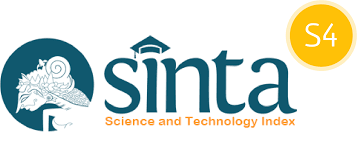Effect of Batik Wastewater Resulted from Biosorption Process to Blood Glucose Level on Carp (Cyprinus carpio)
Abstract
Chromium from the process of coloring batik has high toxicity to the organism. The biosorption method is the heavy metal adsorption process using inactive organisms to eliminate or decrease chromium in batik wastewater. In a polluted environment, fish can be in a stressful condition that requires energy to adapt to environmental changes; high energy requirements will stimulate an increase in blood glucose levels. Chromium exposure can increase the blood glucose level on carp (Cyprinus carpio). This study aims to determine the effect of batik wastewater resulted from the biosorption process exposure to the blood glucose levels. This study used 4 concentrations with 6 replications. Carp is placed in a mixed water tank with batik waste resulting from biosorption. The treatment of batik wastewater produced from the biosorption process concentration are of 0%v.v-1; 39,657%v.v-1; 26,438%v.v-1; and 13,219%v.v-1. Research shows that chromium was decreasing the results obtained at K0 are 68 mg/dL, at K1 is 132 mg/dL, K2 is 127 mg/dL, and at K3 is 116 mg/dL Batik wastewater resulted from biosorption process increasing the blood glucose level in fish and accelerates the rate of expenditure on fish The optimaly concentration of batik wastewater resulted from biosorption process are tried can
Keyword : Batik wastewater, Biosorption, Blood glucose level, Carp
References
Badriyah, S., Agung, B. 2014. Toxicity Test of heavy Metal Cr6+ (Heksavalen Chromium) On Histopatological Liver and Gills on Nile Tilapia (Oreochromis niloticus). Thesis. Sebelas Maret uversity. Surakarta
Lestari, S. S. 2017. Lethal Toxicity of Batik Waste Water Bio-Sorption Result in Tilapia. Advanced Science Letter, 23: 2611-2613.
Masjudi, H., Usman, M. (2016). Kajian tingkat Stres ikan Tapah (Wallago leeri) Yang di Pelihara dengan Pemberian Pakan dan Suhu yang berbeda. Journal Berkala Perikanan Terubuk, 44(3):69–83
Nasichah, Z., P. W. 2016. Analisis Kadar Glukosa Darah Ikan Tawes (Barbonymus gonionotus) dari Bendungan Rolak Songo Hilir Sungai Brantas. Prosing Seminar Nasional. Universiitas Trunojoyo. Madura
Paramita, R.W. (2017). Kandungan Logam Berat Kadmium (Cd) dan Kromium (Cr) di Air Permukaan dan Sedimen; Studi Kasus Waduk Saguling Jawa Barat. Journal Teknik Lingkungan Itenas 5(2):1-12
Rizky Kamiswari.,(2015). Pengaruh Pemberian Detergen Terhadap Mortalitas Ikan. Jurnal online UNS. Universitas Negeri Surabaya. Surabaya
Sari, A.M. (2014). The Effect of Chromium in Liquid Waste of Batik on The Growth of Eichornia crassipes and Salvinia molesta. Journal Lenterabio 3(1):67-71
Silalahi, M. (2017). Biosorption Logam Berat Tembaga (Cu2+) Dalam Air Limbah Industri Lapis Listrik Oleh Kultur Campuran Mikroalga Air Tawar. Teramobalisasi. Journal Pnenlitian dan Karya Ilmiah Lemlit 2(1).
Sumarko, T. H., Sri L. 2013. Deodiorisasi Limbah Cair Batik Menggunkan LImbah Baglog Pleurotus ostreatus Dengan Kombinasi Volume dan Waktu Inkubasi Berbeda. Journal Molekul 8(2): 151-166













